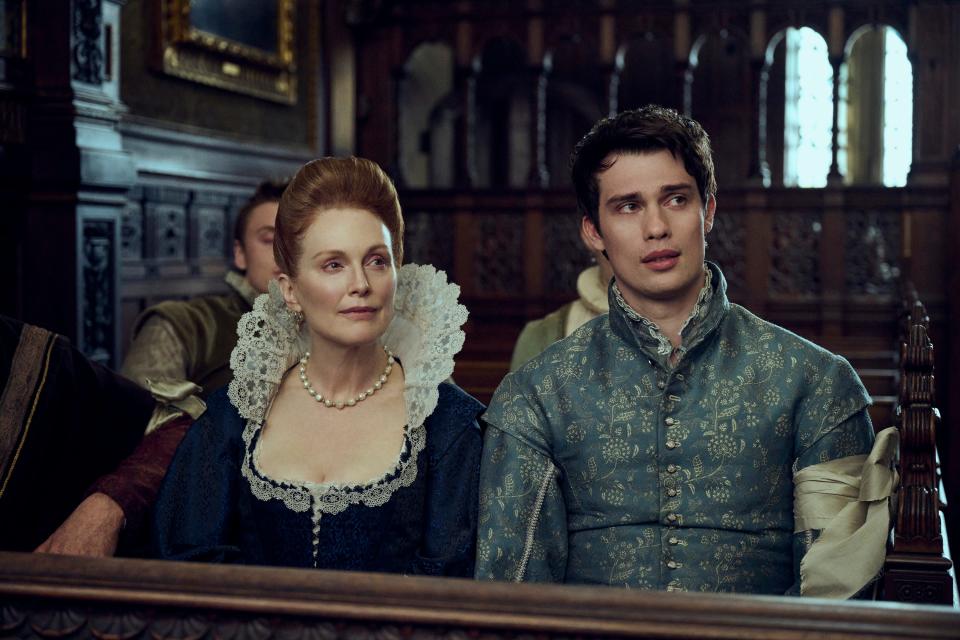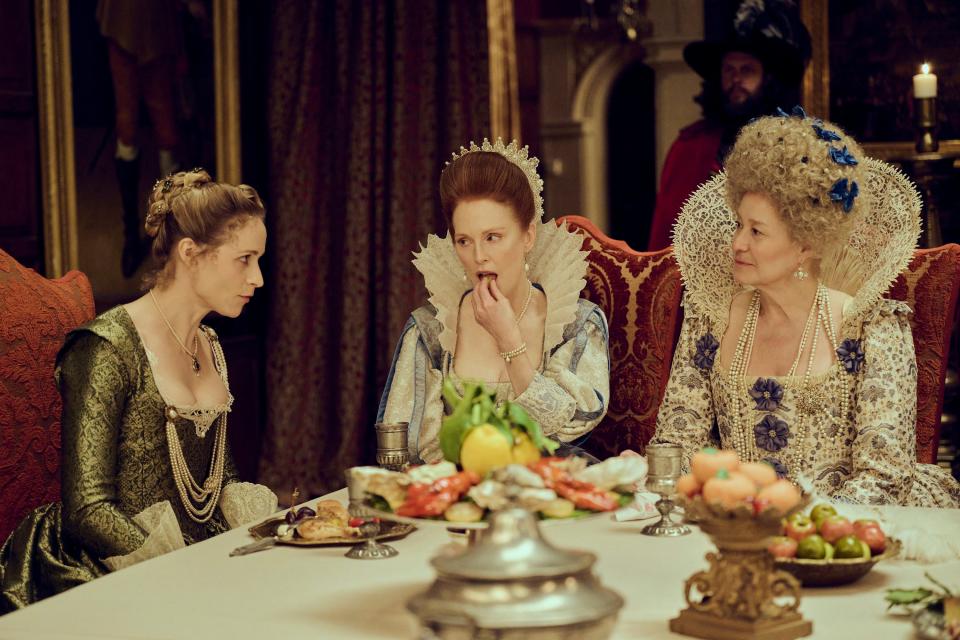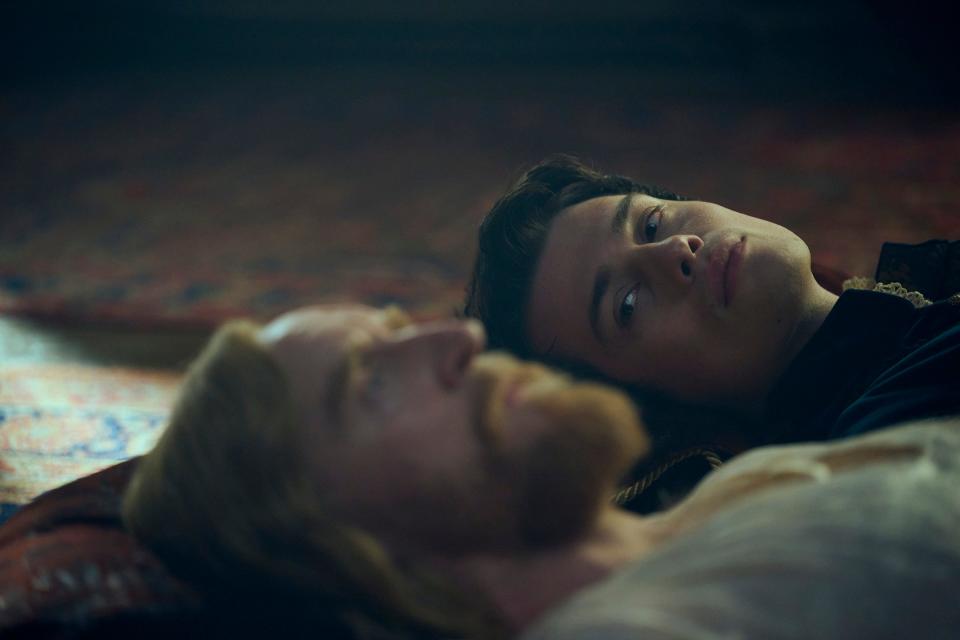'Mary & George' fact check: Did he really love King James? And what about all the orgies?
We all love watching royals behave badly.
Recently, viewers have been served a buffet of raunchy period dramas that don’t skimp on sex and profanity, from Netflix’s fictional “Bridgerton” to Hulu’s satirical “The Great” to Olivia Colman’s Oscar-winning “The Favourite.”
The latest bodice ripper is Starz series “Mary & George” (Fridays, 9 EDT/PDT), which follows social climber Mary Villiers (Julianne Moore) as she pushes her son, George (Nicholas Galitzine), to seduce King James I (Tony Curran) and scheme their way into nobility.
“A lot of past period pieces eradicated this sense of sexuality and fun,” Galitzine says. “If we look at history, there is no rhyme or reason why these things weren’t happening. We’ve had a very chaste approach to telling historical stories, and I think people appreciate more honesty.”
More: Natalie Portman, Julianne Moore on hot dogs, 'May December' and movies they can't rewatch
USA TODAY chats about the real history behind the show with Galitzine, Moore and Benjamin Woolley, author of the 2017 book "The King's Assassin," on which the provocative new series is based.

Who were Mary and George Villiers?
Born in 1570, Mary was a widow with four children and no property who sent her second eldest son, George, to the English court. He quickly became the favorite of King James I, who enjoyed the company of handsome young men. As George rose through the ranks, Mary also gained wealth and nabbed the title of the Countess of Buckingham.
“She had no money and no means of support, and yet she went from that place to being buried in Westminster Abbey,” Moore says. “That’s quite a journey. It’s pretty incredible.”
“It’s one of the most successful rises in social rank in British history,” Woolley adds. “Mary was this crafty figure who managed to weaponize her son to promote her own prospects. She was singularly devoted to that and proved to be the most effective self-promoter in that period of history.”
The seven-episode drama is set over a couple of decades, tracking George from a naive 21-year-old to "a hopeful, aspiring politician to a chaotic, corrupt megalomaniac,” Galitzine says. “That was a really interesting character progression to chart.”

Was Mary's lover, Sandie Brooks, a real person?
Early in the series, Mary goes to a brothel for a secret meeting with Sir David Graham (Angus Wright), where she’s introduced to a prostitute named Sandie (Niamh Algar). Sandie soon falls into bed with Mary and becomes her closest confidante. Their queer romance “was invented for the show,” Woolley says. Based on the limited historical records about her, “it’s hard to get a full picture of Mary. A lot of what we know about her was written by her enemies once she became a prominent member of the court.”
For Moore, Sandie added depth to Mary. “With men, she’s always been in a place where it feels transactional,” she says. “She’s needed men to survive financially. She doesn’t feel she needs Sandie for anything but companionship, and that love and intimacy is something that Mary craves.”

Did George really love King James I?
Historians have debated whether James and George really loved each other and had a sexual relationship.
“I think there probably was a degree of love there, but obviously you have to bear in mind the circumstances that brought it about,” Woolley says. “George would have been dead, essentially, if James had turned against him at any stage during their developing relationship.”
Galitzine believes it was more than just a power play. “You see any of the letters of correspondence between the two of them, and there was genuine love and affection there," he says. "Maybe the approach was Machiavellian, and obviously it benefited him greatly to ascend to this position of power. But that’s something I really loved in the show: that closeness between them and bickering of an old married couple. It makes the show very tragic and sad.”
Who was Katherine Villiers, George's wife?
With James' support, George became an earl, a marquess and ultimately a duke (a rarity for nonroyals). He was betrothed and married to Katherine Manners (Mirren Mack), an English noblewoman, five years before James' death.
“Mary absolutely arranged it,” Woolley says. “The essential part of Mary’s scheme to build a dynasty was to marry off her children to the best people. She resorted to any number of extraordinary tactics to do that. One of them, which is partly dramatized in the series, is Mary essentially locked (Katherine and George) in a room together” to give the impression that they were intimate.
“Katherine’s father thought that Mary was impossibly vulgar,” Woolley says. But he couldn’t refuse the marriage, otherwise, Mary would smear Katherine by “depicting her as soiled goods.”

Did all those orgies actually happen?
Like many Starz series, "Mary & George" has many graphic sex scenes with George and James and groups of men. George, as depicted in the show, had “a voracious sexual appetite,” Galitzine says. “We do this montage when he gets to the Spanish court and he's been sleeping with everyone, trying to execute a level of control over the situation. There are so many stories about George, (including) bedding the queen of France."
The extent of the show's orgies is up for historical debate. “Intimacy between men at the time was commonplace. There was a much more carefree attitude toward those things,” Woolley says. That said, while it's possible James may have had orgies, "this is drama; it's not history. There was nobody in the king’s bedroom at the time he was having relations with George. But there are fairly explicit references in their correspondence, which suggests a very physical, close relationship.”
This article originally appeared on USA TODAY: 'Mary and George': What's fact, fiction in Julianne Moore's Starz show
